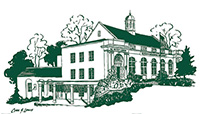Local History
From the Bryant Room
Christopher Morley
Eliminating a Bottleneck: An excerpt from “Saint Bypass” by Christopher Morley (1947)
By Carol L. Clarke
November/December 2017
Historical Note: The years following World War Two were a time of great change in Roslyn. Work on a bridge over Hempstead Harbor, first proposed by New York State in 1927, began in earnest in 1946. With a steady increase in automobile traffic, Northern Boulevard, which wound down the hill through Roslyn Village’s downtown business district, had become “one of the county’s most hazardous bottlenecks.” The bridge had been vigorously opposed by Roslyn’s civic and business leaders on the grounds that it would make the Harbor and docks inaccessible to pleasure and business craft, destroy the ball park and other grounds used by residents for recreation, and “be a serious injury to the business interests of Roslyn, Long Island.” Although the proposal was ultimately approved by the State, the project had been repeatedly delayed, first by lack of funds and then by the war.
By 1946, acquisition of land and condemnation of properties was underway. Bryant Hall, Roslyn’s first library building, which stood on Bryant Avenue immediately north of where Diane’s Bakery is now located, was an early casualty of the project. According to one newspaper account, the homes of 70 families were in the path of the bridge. Construction began in 1947, and on January 2, 1950, barricades were removed and the first cars were allowed to cross the Roslyn Viaduct. The impact on Roslyn’s downtown was felt immediately. A letter written by a local business owner in March 1950 notes “Our bridge has taken about all the traffic and it is very quiet now in the old village.” He reports that “the 2 gas stations have been hit very heavy” and several local businesses “closed down for the winter.”
In his 1947 essay, “Saint Bypass,” Christopher Morley provides a satirical take on the construction process and its impact on the Roslyn community, focusing on the members of the church he calls “Saint Bypass-under-the-Bridge.” “Saint Bypass” is Trinity Church, located on the north side of Northern Boulevard. Morley, who resided in Roslyn Estates from 1920 until his death in 1957, frequently used the pseudonyms “Salamis” and “Wending Ways” when writing about Roslyn. “Saint Bypass” was originally published in The Ironing Board by Christopher Morley (Doubleday & Company, Inc., 1949).
“A conscientious War Department, or triunified service, thinks about things a long time ahead (I hope it’s a long time). One of its anxieties is getting the populace (that’s you and me) Out of Town when Disaster comes.” … So they try to eliminate bottlenecks. One of the most intestinal constipations for outbound traffic from Vulnerable City is the long narrow bending dip through Wending Ways, a modest old bailiwick some twenty-five miles away. The Army decided to short-circuit it. The local Lions Club roared, and the Kiwanis Club resolved, and a couple of high-priced roadhouses took most of the clams out of their chowder; but War has Eminent Domain. Grinding slow but small (like the chowder-chef), it condemned enough property to clear its Right of Way. It plotted a huge viaduct across Wending Harbor. The village, lingering in an acute angle of low tide and lethargy, was cut out of arterial flow.
The great white viaduct was nerved with steel, fleshed with concrete, hypothecated with taxpayers. Countenanced by Congress, guaranteed by the Governor (he never visits our county, he gets 80 per cent of our vote by mesmerism), the noble structure strode. Strode? I mean leaped, level and luminous from hill to hill. The old sentimental village where William Cullen Bryant, or William Jennings Bryant (I get confused myself), wrote Thanatopsis, or The Cross of Gold, was left out on a limb.
Down in their anxious lagoon the citizens bubbled like frustrated frogs. Who, now, would drive down their picturesque gulley, where the antique furniture was all ready on the sidewalk, where the house waited in which Washington only had breakfast and didn’t spend the night? (He knew those corn-shuck mattresses, and hastened on to the Astor House.) On the high six-lane bridge, fit for the flight of a Tarter tribe, hell and holiday went whickering by. Unless you were on the right-hand strip, no one pushing your bumper, and had on your new glasses (to read the miniscule sign: WENDING WAYS, next right turn, 1000 feet), you couldn’t divert to the deserted village. It was cut off, like a fecalith appendix.
All this time, and a long time before that, there was a patient little church in Wending Ways, dedicated to the holy hermit Saint Bypass. It stood on the far side of the village, just where the retorted turnpike has another crick in its bottleneck and climbs from the entrails of town toward the lungs of the eastern highland. … While the Army’s great construction was proceeding, the plight of Saint Bypass was grim. Long scalene limbs of cranes waved above the modest belfry; roaring tractors, concrete mixers, pile drivers, deafened the neighborhood. The rectory, never too sturdy and perched on a slope, quaked like blanc-mange. …
To read the complete essay or to view the Library’s Christopher Morley Collection of books and memorabilia, please visit the Bryant Room Local History Collection.
Category: Christopher Morley; Places and Events
